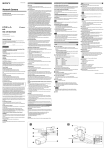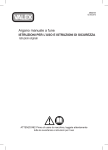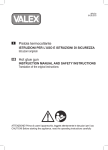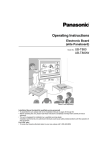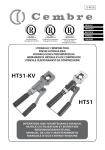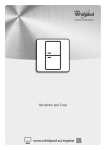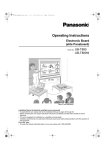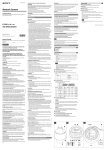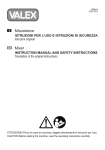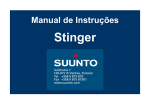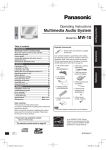Download Verricello manuale a fune Manual cable winch
Transcript
MVerMan 09.02.2015 Verricello manuale a fune ISTRUZIONI PER L’USO E ISTRUZIONI DI SICUREZZA Istruzioni originali Manual cable winch INSTRUCTION MANUAL AND SAFETY INSTRUCTIONS Translation of the original instructions ATTENZIONE! Prima di usare la macchina, leggete attentamente le istruzioni per l’uso CAUTION! Before starting the machine, read the operating instructions carefully i ATTENZIONE! Leggete ed applicate attentamente le istruzioni di seguito riportate che fanno riferimento ai disegni ed ai dati tecnici contenuti nel foglio allegato. La mancata ottemperanza alle avvertenze e alle istruzioni può dare luogo a incidenti e/o lesioni serie. La scrupolosa osservanza di queste avvertenze con l’utilizzo dei mezzi di protezione individuale, minimizzano i rischi di incidente ma non li eliminano completamente. Utilizzate l’apparecchio solo nei modi descritti in queste istruzioni. Non utilizzatelo per scopi a cui non è destinato. Conservare tutte le avvertenze e le istruzioni per riferimenti futuri. Queste istruzioni si riferiscono ad un apparecchio fabbricato in più modelli e versioni; leggete attentamente le istruzioni ed applicatele all’apparecchio in vostro possesso. AVVERTENZE DI SICUREZZA 1) Sicurezza dell’area di lavoro a) Tenere pulita e ben illuminata l’area di lavoro. Le aree ingombre e/o poco illuminate possono provocare incidenti. b) Non installare o far funzionare l’apparecchio in atmosfere aggressive, esplosive o corrosive. Non esporre alla pioggia o all’umidità. Le condizioni ambientali possono deteriorare l’apparecchio e renderlo pericoloso all’uso. c) Tenere i bambini e i passanti a distanza durante il lavoro. Le distrazioni possono far perdere il controllo dell’apparecchio. Delimitate l’area con opportune barriere anti-intrusione e con segnalazione di avvertimento. d) Mantenete in un luogo sicuro i sacchi di nylon presenti nell’imballaggio. I sacchi possono provocare il soffocamento e i bambini non devono entrarne in possesso. 2) Sicurezza personale a) Non distrarsi mai, controllare quello che si sta facendo e usare il buon senso. Non azionare l’apparecchio quando si è stanchi o sotto l’influsso di droghe, alcol o medicinali. Un momento di disattenzione può dare luogo - 2 - a serie lesioni personali. b) Usare sempre delle protezioni personali. Indossare sempre protezioni per le mani e i piedi. Le apparecchiature di protezione quali guanti di protezione, calzature di sicurezza antiscivolo e vestiario robusto riducono la possibilità di subire lesioni personali. c) Non sbilanciarsi. Mantenere sempre la posizione e l’equilibrio appropriati. Questo permette di controllare meglio l’apparecchio in situazioni impreviste. d) Mantenete una posizione adeguata all’azionamento dell’apparecchio. Una distanza di sicurezza dalla zona di movimentazione e la piena visibilità riducono il rischio di incidenti. e) Vestirsi in modo appropriato. Non indossare vestiti larghi o gioielli. Tenere capelli, indumenti e guanti distanti dalle parti in movimento. Vestiti larghi, gioielli o capelli lunghi possono impigliarsi nelle parti in movimento. f) L’uso dell’apparecchio è vietato ai bambini e alle persone inesperte non a conoscenza di queste istruzioni. Leggi o regolamenti locali possono prevedere una età minima. g) L’utilizzatore è responsabile verso terzi di eventuali incidenti o danni a persone o cose. Un uso improprio provoca incidenti e lesioni anche gravi. h) Non utilizzare l’apparecchio se è guasto, in non perfette condizioni, o è sprovvisto dei componenti di sicurezza. Un apparecchio in perfette condizioni e completo di ogni componente consente un utilizzo in sicurezza. 3) Uso dell’apparecchio a) Usare l’apparecchio in conformità con queste istruzioni, tenendo conto delle condizioni ambientali e dell’operazione da eseguire. L’uso dell’apparecchio per operazioni diverse da quelle previste può dare luogo a situazioni pericolose. b) Riporre l’apparecchio inutilizzato fuori della portata dei bambini e non permetterne l’uso a persone inesperte o che non conoscano queste istruzioni. L’apparecchio è pericoloso se utilizzato da persone inesperte. c) Non forzare l’apparecchio. L’apparecchio appropriato permette di eseguire il lavoro con maggiore efficienza e sicurezza senza superare i parametri d’uso previsti. d) Togliere le chiavi di regolazione prima dell’uso. Assicuratevi di aver rimosso tutti gli attrezzi dall’apparecchio e dalla zona di lavoro. 4) Manutenzione dell’apparecchio a) Effettuare la manutenzione necessaria. Verificare il bloccaggio delle parti in movimento, la rottura delle parti, lo stato della fune e qualsiasi altra condizione che possa influenzare il funzionamento dell’apparecchio. Se è danneggiato, far riparare l’apparecchio prima di utilizzarlo. Numerosi incidenti sono provocati proprio dal cattivo stato di manutenzione. b) Non modificate l’apparecchio. Togliere, sostituire o aggiungere componenti non previsti dalle istruzioni, è vietato ed annulla la garanzia. c) Non eseguite riparazioni fai da te come: saldature, giunzioni con morsetti, sostituzione con componenti non originali, utilizzo di accessori non idonei ecc. In queste condizioni non è più assicurata la funzionalità in sicurezza e sono possibili incidenti anche gravi. 5) Assistenza a) Far riparare l’apparecchio solo da tecnici qualificati e utilizzare soltanto ricambi identici. Questo garantisce la costante sicurezza dell’apparecchio. b) Non tentare di riparare l’apparecchio o accedere ad organi interni. Interventi effettuati da personale non qualificato e non autorizzato dal costruttore può generare seri pericoli ed annulla la garanzia. c) Richiedete solo ricambi originali. L’utilizzo di ricambi non originali può compromettere la sicurezza. AVVERTENZE DI SICUREZZA DEL VERRICELLO MANUALE A FUNE a) L’uso del verricello è consentito esclusivamente per la movimentazione di carichi di peso compreso nella capacità massima indicata nella targa dati della macchina. È vietato movimentare carichi con peso superiore a quello consentito. b) È vietato movimentare materiali sfusi e materiali non imbragati correttamente. E’ vietato movimentare materiali fusi, acidi, liquidi o gas pericolosi, materiali fragili, materiali esplodenti, materiali che per loro forma potrebbero rotolare/scorrere/scivolare senza controllo o cadere di lato a causa della loro eccessiva altezza rispetto alla loro base. c) È vietato movimentare persone e animali. d) Le operazioni di movimentazione vanno effettuate con le modalità e utilizzando gli accessori di imbracatura (funi, anelli, golfari, ecc.) idonei e conformi alle leggi e norme in vigore nel Paese dove avvengono le suddette operazioni. Gli accessori riportano stampigliato il loro carico max; non effettuate movimentazioni di pesi a questi valori ma rispettate sempre quelli dei dati tecnici della macchina. Non usate imbracature elastiche. e) È vietato passare in prossimità del carico da movimentare e in prossimità della fune. f) È vietato sostare o circolare vicino al carico. Segnalare e vietare l’accesso alla zona situata sotto. g) È vietato usare la fune del verricello per imbragare il materiale. h) È vietato effettuare movimentazioni con angolazioni della fune. i) È vietato abbandonare per qualsiasi motivo il verricello incustodito con il carico in tensione. l) È obbligatorio verificare, prima di iniziare ad operare con il verricello, la stabilità e l’idoneità del supporto a cui viene fissato il verricello. m) È obbligatorio verificare, prima di iniziare ad operare, che il verricello sia integro in tutte le sue parti ed in grado di funzionare perfettamente. Controllate che tutta la viteria sia ben serrata. n) Prima di utilizzare questa apparecchiatura per la prima volta, verificare, senza rischi, prima di applicare il carico, di essere a conoscenza delle misure di sicurezza necessarie per la sua manovra. o) È obbligatorio verificare, prima di iniziare ad operare, lo stato di usura della fune. Eliminare immediatamente qualsiasi fune che presenti segni evidenti di deterioramento (fig. H). p) In caso di problemi di funzionamento interpellate il centro assistenza autorizzato evitando così interventi non mirati. q) L’operatore deve posizionarsi in modo da avere la piena visibilità della zona di manovra, onde poter intervenire tempestivamente in caso di pericolo. Mantenete una distanza di sicurezza dalle parti in movimento; in particolare stare lontani dalla zona di rotazione della manovella. r) Assicuratevi di lasciare sempre almeno 5 giri di fune avvolti sul tamburo. Non svolgete mai completamente la fune dal tamburo (fig.L). s) Verificate sempre il corretto modo di avvol- 3 - gimento della fune sul tamburo. Verificare il corretto fissaggio della fune al tamburo. t) Per evitare che la fune esca dal tamburo non eccedere con la lunghezza totale della stessa ossevando quanto prescritto in fig.M. u) Non effettuare tiri con angolo di inclinazione rispetto al senso di marcia maggiori di 4°, vedere fig.N v) Non trattenere la fune con le mani. Non far scorrere la fune sulla mano. v) Non sganciare mai il carico se la fune del verricello è in tensione. z) Non utilizzare il verricello per scopi a cui non è destinato. a1) Utilizzate il verricello solo nei modi descritti in queste istruzioni. b1) Accertarsi durante l’utilizzo che il cavo sia costantemente teso dal peso del carico, che il movimento non sia temporaneamente impedito da un ostacolo, cosa che potrebbe comportare il rischio di rottura del cavo nel momento in cui il carico si libera del suo ostacolo. Attenzione: Per l’intervento del freno è richiesta una forza di trazione minima di 25 kg. Attenzione: Per un corretto funzionamento del freno è necessario lasciare installata la maniglia. RISCHI RESIDUI Schiacciamento degli arti o del corpo a causa di errate movimentazioni del carico. Per la vostra incolumità mantenete una distanza di sicurezza dal carico ed indossate i dispositivi di protezione individuale. - 4 - DESCRIZIONE MARCHIATURE (Fig.b) Osservate con attenzione la simbologia della fig.B e memorizzate il rispettivo significato. Una corretta interpretazione dei simboli consente un uso più sicuro della macchina. 1 Modello, dati tecnici e marchi di certificazione (se presenti) 2 Nr. lotto e anno di fabbricazione 3 Attenzione! 4 Leggete con attenzione tutte le istruzioni prima dell’uso. 5 Indossate guanti di protezione. 6 Indossate calzature di protezione. 7 Mantenete una distanza di sicurezza dalle parti in movimento. 8 Non utilizzate l’apparecchio in presenza di pioggia o umidità. 9 Non utilizzare questo apparecchio ad una temperatura inferiore a 0°C o superiore a +45°C. 10 Attenzione! Pericolo caduta materiale. È vietato passare o sostare sotto i carichi e nella zona di manovra. È vietato utilizzare la macchina se ci sono persone nella zona di manovra. ___________________________________ Vi ringraziamo per averci preferito nella scelta di late l’apparecchio in zone di transito veicolare questo prodotto, di seguito chiamato “verricello e/o pedonale. manuale a fune”. MESSA IN SERVIZIO Questo istruzioni riportano le informazioni e !! ATTENZIONE! La Ditta Costruttrice declina quanto ritenuto necessario per il buon uso, la ogni responsabilità per gli eventuali danni diconoscenza e la normale manutenzione della retti e/o indiretti causati da errate installazioni. macchina. Esse non riportano le informazioni Nella scelta di utilizzo dell’apparecchio è opporsulle tecniche di movimentazione dei carichi; tuno considerare: l’utilizzatore troverà maggiori notizie su libri e - che l’ambiente non sia in atmosfera aggressiva pubblicazioni specifiche o partecipando a corsi o corrosiva. di specializzazione. - che attorno alla zona di lavoro sia prevista un’ampia zona operativa libera da impedimenti. - che sia impedito il libero accesso alla zona COMPONENTI di lavoro. Fare riferimento alla fig. A e seguenti, allegate - che vi sia una buona illuminazione. - che la posizione prevista non sia umida e sia alle presenti istruzioni. al riparo dagli agenti atmosferici. 1 Manovella di azionamento -che la temperatura di utilizzo sia compresa tra 2 Albero +5°C / +40°C. 3 Tamburo 1) Aprite la parte superiore dell’imballo e verifi 4 Viti di fissaggio maniglia cate visivamente che l’apparecchio sia integro, 5 Fori di fissaggio senza deformazioni o principi di corrosione. 6 Freno (se presente) 2) Estraetelo dall’imballo e procedete ad una 7 Fune (se presente) pulizia generale. 8 Gancio (se presente) 3) Effettuate una accurata ispezione visiva di 9 Sicura (se presente) tutti i componenti per scoprire eventuali rotture, 10 Dado bloccaggio fune (se presente) deformazioni, corrosioni che compromettereb11 Piastrina di bloccaggio fune (se presente) bero la funzionalità. 12 Protezione 4) Leggete attentamente le istruzioni d’uso fornite a corredo (il presente manuale e gli allegati) e procedete all’installazione seguendo scruINSTALLAZIONE polosamente le istruzioni di seguito indicate. TRASPORTO 5) Per verricello provvisto di fune: lubrificate la Per trasportare l’apparecchio utilizzate sempre fune spalmando con un pennello un leggero il suo imballo; questo lo preserverà da urti, polstrato di grasso. vere e umidità che ne possono compromettere 6) Per verricello senza fune: il regolare funzionamento. -procuratevi dal vostro rivenditore di fiducia una fune d’acciaio a trefoli da verricello, con STRUTTURA DI SUPPORTO La struttura di supporto (non inclusa) deve esse- caratteristiche indicate nei dati tecnici allegati e re di dimensioni adeguate a garantire il perfetto di lunghezza adeguata o acquistate il ricambio fissaggio del verricello mediante la bulloneria originale, se disponibile. In particolare la fune (non inclusa). Inoltre essa deve essere in grado deve essere costruita nel rispetto delle nordi reggere i carichi statici e dinamici, ed essere mative vigenti e garantire un carico di rottura adeguatamente vincolata in ottemperanza alle minimo; leggete con attenzione i dati tecnici leggi, direttive e norme in vigore nel Paese dove forniti con la fune. avvengono le suddette operazioni. Il dimensiona- -installate una estremità della fune nel tamburo mento e l’esecuzione della struttura deve essere del verricello rispettando la sequenza di pasaffidata a personale competente; il verricello può saggio della fune indicata nelle foto C1 e C2. diventare una macchina pericolosa se fissata -effettuate una prova di trazione in modo da verificare che la fune non si sfili dal tamburo ad una struttura insufficientemente resistente. -assicurate la fune sotto la piastrina di fissaggio L’installazione e l’uso deve avvenire in ambiente (fig.C1, pos.11) e serrate fortemente il dado protetto dalla pioggia e dalla polvere. Non instal(fig.C1, pos.10). - 5 - -avvolgete la fune sul tamburo (figg.C-D) rispettando il senso di avvolgimento indicato dalla freccia presente sul tamburo. -lubrificate la fune spalmando con un pennello un leggero strato di grasso. 7) Montate la manovella (pos.1) e la relativa piastrina (se presente) sull’estremità dell’albero (pos.2) ed avvitate a fondo le 2 viti di bloccaggio (fig.A, pos.4) 8) Posizionate il verricello sulla struttura di sostegno (non inclusa) e fissatelo mediante bulloni (non inclusi) in acciaio zincato filettatura M10 di classe minima 8.8, con rondelle di sicurezza e dadi antisvitamento, lunghezza secondo necessità (fig.E). 9) Assicuratevi che il verricello sia fissato orizzontalmente (non in posizione inclinata o ruotata rispetto ai punti di ancoraggio) utilizzando una livella a bolla (non inclusa). 10) Delimitate la zona ed installate i necessari segnali di pericolo movimentazione carichi e divieto di transito. CONTROLLI PRELIMINARI Controllare prima di ogni utilizzo: 1. Che il carico/sforzo a cui è sottoposto il verricello sia inferiore o uguale al carico massimo di utilizzo. 2. Che la resistenza della struttura di supporto sia sufficiente per applicare in sicurezza uno sforzo uguale al carico massimo di utilizzo. 3. Che l’ancoraggio sia corretto.(fig.N) 4. Che il cavo di sollevamento sia in buono stato (vedere fig.H). 5. Che nessun ostacolo impedisca il movimento del braccio dell’utilizzatore quando si fa ruotare la manovella di azionamento. 6. Che nessun ostacolo impedisca il completo movimento di rotazione della manovella di azionamento. 7. Che l’operatore possa controllare costantemente l’azione del carico lungo tutto il suo percorso. 8. Che la zona di lavoro sia messa in sicurezza in conformità alle leggi in vigore. 9. Che la lunghezza del cavo di sollevamento sia sufficiente ad agganciare il carico. Il tamburo non dovrà mai essere svolto completamente, conservare almeno 5 giri residui (fig.M). 11. Che non siano presenti ostacoli contro i quali il carico o il cavo di sollevamento possono entrare in contatto. 12. Che il gancio sia integro e in buono stato, la sicura (pos.9 fig.A) deve poggiare al centro del becco del gancio e l’azione della molla deve essere efficace. 13. Che l’insieme dei sistemi di sicurezza del verricello (freno automatico, manovella con autobloccaggio, gancio, carter ) siano integri e funzionanti. 14. Che il sito di installazione sia stato studiato per limitare al massimo il rischio di incidenti. 15.Che l’installatore sia fornito di tutti i dispositivi di protezione individuale necessari (attrezzature anticaduta, guanti, calzature di sicurezza, casco) per portare a buon fine l’installazione. 16. Che l’ambiente dove l’apparecchio viene utilizzato non presenti pericolo di esplosione. 17.Che l’ambiente di utilizzo non sia esposto all’umidità o particolarmente corrosivo, di tipo marino o similare. 18. Che prima dell’utilizzo il verricello non sia bagnato, in questi casi lasciare asciugare completamente . 19. L’ambiente di manovra e il percorso del carico sia sufficientemente illuminato per compiere tutte le operazioni in sicurezza. 20. Che la manovra avvenga in assenza di vento. 21. Che Il carico da spostare sia effettivamente un carico di materiale e non un carico di persone. ISTRUZIONI D’USO !! ATTENZIONE! Prima di usare l’apparecchio è obbligatorio indossare guanti di protezione, calzature di sicurezza antiscivolo e vestiario robusto (non inclusi). !! ATTENZIONE! Durante l’utilizzo fate in modo che nessuno si avvicini alla vostra zona di lavoro. Dopo aver letto attentamente i capitoli precedenti, seguite scrupolosamente i seguenti consigli d’uso che vi permetteranno di ottenere il massimo delle prestazioni. Procedete con calma, solo dopo aver acquisito una buona esperienza riuscirete a sfruttarne a fondo le potenzialità. CARICO DA MOVIMENTARE - Verificate che il carico da movimentare non 10. Che il luogo di posizionamento del carico da ecceda la capacità massima prevista per il spostare , sia adatto in termini di sicurezza ( ac- verricello. cessibilità, resistenza, aderenza) al carico stesso. - Imbragate correttamente il carico in modo da - 6 - impedire il suo sganciamento durante le successive operazioni di movimentazione. - Gli accessori di movimentazione (non inclusi), usati per imbragare il carico, devono essere sempre perfettamente integri e correttamente dimensionati per resistere alle forze agenti. MOVIMENTAZIONE !! ATTENZIONE! Trattenete sempre con forza la manovella sull’impugnatura sia in fase di sollevamento che di rilascio del carico. Prima di usare del verricello, accertatevi di essere in una posizione stabile, sicura e con ampio campo visivo in modo da avere pieno controllo della zona di manovra. Mantenete una distanza di sicurezza dall’apparecchio e dal carico. In particolare la rottura improvvisa della fune in tensione potrebbe generare un “colpo di frusta”, scagliando la fune contro l’operatore; perciò non operate in linea alla fune, ma rimanete a fianco del verricello sul lato manovella con lo sguardo sul carico e sulla fune. Non avvicinate il viso alla zona di rotazione della manovella e mantenete una distanza di sicurezza da essa. 2) Sganciate la fune dal carico. 3) Riavvolgete la fune sul verricello. Se osservate delle anomalie di funzionamento arrestate l’apparecchio e consultate il capitolo “Problemi, cause e rimedi”. MANUTENZIONE !! ATTENZIONE! Prima di ogni controllo o manutenzione sganciare la fune dal carico. PULIZIA E LUBRIFICAZIONE Pulite regolarmente ed abbiate cura del vostro apparecchio, vi garantirete una perfetta efficienza ed una lunga durata dello stesso. Durante la pulizia effettuate i controlli visivi per rilevare eventuali rotture. Rimuovete la polvere utilizzando uno straccio o una spazzola morbida. Mantenete l’impugnatura della manovella ben pulita e priva di tracce di grasso. Lubrificate con un leggero strato di grasso la fune e gli ingranaggi del verricello. Attenzione! Non lubrificare mai i componenti del freno stesso. Ispezionate la fune e il gancio prima di ogni uso. Controllo generale : Effettuate un controllo generale dell’apparecchio per prevenire possibili guasti ed incidenti. Il controllo generale deve essere eseguito da un centro assistenza autorizzato, ad intervalli di 12 mesi e comunque dopo ogni riparazione o riassemblaggio; se l’apparecchio è utilizzato per un funzionamento frequente è necessario ridurre i tempi tra un controllo e il successivo. Verificate l’assenza di rotture, deformazioni, cricche, piegamenti, schiacciamenti, usura, corrosione. Controlli periodici : Effettuate i controlli periodici del verricello seguendo la tabella specifica riportata in questo documento. Movimentazione carico 1) Stabilite in quale direzione dovrà movimentarsi il carico, verso il verricello (trazione) o in senso opposto al verricello (rilascio). 2) Agganciate la fune (pos.7) al carico mediante il gancio (pos.8) e verificate che la sicura (pos.9) sia completamente chiusa sul gancio. 3) Con fune non in tensione azionate la manovella di manovra in senso orario ( fig.F), il carico viene spostato e l’argano dovrà emettere uno schiocco continuato, che corrisponde al rumore del dente d’arresto sulla cremagliera della ruota. Quando viene rilasciata la manovella di manovra, il carico deve rimanere immobile. 4) Ruotare la manovella in modo continuo ed uniforme, senza colpi secchi e senza aiutarvi con leve di prolunga. 5) Movimentate il carico fino a spostarlo in una zona pianeggiante e sicura, in modo che non Non effettuare riparazioni fai-da-te come saldapossa muoversi quando sarà sganciato dalla ture, giunzioni di fune, sostituzione del gancio... fune. Registrate sempre i controlli eseguiti ed eventuali Allentamento della fune in tensione riparazioni. 1) Mantenendo ben salda la manovella ed applicando ad essa una forza resistente, azionate SOSTITUZIONE DELLA FUNE la manovella di manovra in senso antiorario ( Per la sostituzione della fune seguite Ie istruzioni fig.F), il carico verrà rilasciato progressivamen- del paragrafo “messa in servizio”, punto 6. te e il verricello manterrà l’azione frenante. In questo verso il verricello non emette schiocchi. - 7 - PROBLEMI, CAUSE E RIMEDI PROBLEMA CAUSE RIMEDI Non movimenta il Eccessivo peso carico del carico Ridurre il peso del carico Il carico è incastrato e non può scorrere Liberare il carico dall’ostacolo Guasto dell’apparecchio Rivolgetevi ad un centro di assistenza autorizzato Non frena il carico Sistema frenante Rivolgetevi ad un guasto centro di assistenza autorizzato Fune deformata, schiacciata, usurata, con filamenti spezzati (fig.H) L’avvolgimento sul tamburo è stato eseguito accavallando la fune su se stessa (incrocio) Rivolgetevi ad un centro di assistenza autorizzato Fune con trac- Ciclo di utilizzo Sostituire le fune ce di usura o di giunto al termine oppure rivolgetevi ad un centro di asossido sistenza autorizzato Movimentazione del carico invertita rispetto alla rotazione della manovella Fune avvolta in senso contrario (errato) sul tamburo Svolgere completamente la fune dal tamburo e riavvolgerla nel modo corretto. Effettuare un controllo di tutta la fune. Sollevando un carico l’argano non emette uno schiocco continuato Le molle del dente d’arresto sono rotte oppure il dente di arreso è rotto o inceppato. Portare il verricello presso un centro di assistenza autorizzato. Sforzo sulla ma- Tamburo incep- Portare il verricello novella ecces- pato sul suo asse presso un centro sivo. di rotazione. di assistenza autorizzato Carico ecces- Ridurre il carico e sivo. rispettando il valore riportato nei dati tecnici. !! ATTENZIONE! Se dopo aver eseguito gli interventi sopra descritti l’apparecchio non funziona correttamente o in caso di anomalie diverse da quelle indicate, portatelo presso un centro di assistenza autorizzato esibendo la - 8 - prova di acquisto e richiedendo ricambi originali. Fate sempre riferimento alle informazioni riportate sull’etichetta dati tecnici. Guasto del verricello con carico in tensione È possibile che il verricello si guasti e si blocchi o la fune cominci a rompersi (rottura di alcuni filamenti) mentre il carico è in tensione. In questo caso non tentate di riparare il verricello in quanto c’è la possibilità che il carico si sposti improvvisamente con notevole pericolo per le persone e le cose. Procedete come segue: - una persona deve vigilare la zona in modo da allontanare estranei e veicoli - fate intervenire una gru o simile per agganciare il carico, metterlo in sicurezza e sganciarlo dal verricello guasto. Queste operazioni sono pericolose e devono essere eseguite da personale specializzato con attrezzature idonee alle situazioni di emergenza. Le indicazioni sopra riportate sono consigli generici per evitare incidenti; la situazione di pericolo o gli avvenimenti potrebbero imporre azioni diverse che non possono essere previste da queste istruzioni, agite perciò di conseguenza. IMMAGAZZINAMENTO Effettuate una accurata pulizia di tutto l’apparecchio e sue parti accessorie (vedi paragrafo Manutenzione). Utilizzate l’imballo originale per proteggerlo. Riponete l’apparecchio lontano dalla portata dei bambini, in posizione stabile e sicura. Il luogo dovrà essere asciutto, privo da polveri, temperato e protetto dai raggi solari diretti. Al locale di rimessaggio non devono avere accesso i bambini e gli estranei. SMALTIMENTO Per la salvaguardia ambientale procedete secondo le leggi vigenti del Paese in cui vi trovate. Quando l’apparecchio non è più utilizzabile né riparabile, consegnatelo con l’imballo ad un punto di raccolta per il riciclaggio. GARANZIA Il prodotto è tutelato a norma di legge contro non conformità rispetto alle caratteristiche dichiarate purché sia stato utilizzato esclusivamente nel modo descritto dalle istruzioni, non sia stato manomesso in alcun modo, sia stato conservato correttamente, sia stato riparato da tecnici autorizzati e, ove previsto, siano stati utilizzati solo ricambi originali. In caso di utilizzo industriale o professionale oppure in caso di impiego simile la garanzia ha validità di 12 mesi. Per emettere una richiesta di intervento in garanzia è necessario presentare la prova di acquisto al rivenditore o ad centro assistenza autorizzato. MODIFICHE Testi, figure e dati corrispondono allo standard aggiornato all’epoca della stampa delle presenti istruzioni. Il costruttore si riserva la facoltà di aggiornare la documentazione qualora venissero apportate delle variazioni alla macchina, senza incorrere per questo in alcun obbligo. Controlli periodici Effettuate i controlli periodici del verricello secondo la tabella seguente. I controlli sono obbligatori e servono a prevenire possibili guasti ed incidenti. Devono essere eseguiti alla prima installazione e agli intervalli indicati; se il verricello è utilizzato per un funzionamento frequente e/o con carichi prossimi al massimo consentito è necessario ridurre i tempi di intervallo riportati di seguito. Verificate l’assenza di deformazioni, chicche, piegamenti, schiacciamenti, usura, corrosione. Registrate sempre i controlli eseguiti ed eventuali riparazioni. Dati verricello Tipo verricello (capacità max) Codice Nr. lotto Data di acquisto Controlli Intervallo FUNE METALLICA Controllo rottura filamenti Controllo piegature, schiacciamenti Controllo riduzione di diametro Controllo corrosione Ad ogni utilizzo GANCIO Controllo incrinature Controllo punti rottura Controllo sicura Data e firma Data e firma Data e firma Ogni 3 mesi FRENO Controllo freno Ogni 3 mesi VITI DI FISSAGGIO Controllo viteria Controllo elementi portanti e di movimento Controllo corrosione sull’apparecchio Ogni 3 mesi CONTROLLO GENERALE A cura di un centro assistenza autorizzato Ogni 12 mesi - 9 - g IMPORTANT! Read the instructions below that refer to the drawings and technical data and apply them carefully. Failure to comply with the warnings and instructions may cause serious accidents and/or injuries. Strict observance of these warnings with the use of personal protective equipment minimises risks of accidents but does not completely rule them out. Only use the appliance as described in these instructions. Do not use it for purposes for which it was not intended. Store all warnings and instructions for future reference. These instructions refer to an appliance that is manufactured in several models and versions. Carefully read and observe the safety standards and operational instructions provided hereafter. SAFETY WARNINGS 1) Safety in the work area a) Keep the work area clean and well lit. Cluttered and/or badly lit areas may cause accidents. b) Do not install or operate the appliance in aggressive, explosive or corrosive environments. Do not expose this appliance to rain or moisture. The environmental conditions can deteriorate the appliance and make it dangerous to use. c) Keep children and passers-by at a distance during work. Distractions may cause you to lose control of the appliance. Mark off the area with appropriate anti-intrusion barriers and place warning signs. d) Keep the nylon packaging bags in a safe place. Bags can cause suffocation and must be kept out of the reach of children. Always wear hand and foot protection. Protection equipment such as protective gloves, anti-slip safety shoes and strong clothing reduces the possibility of personal injuries. c) Do not lose your balance. Always keep an appropriate position and balance. This allows better control of the appliance in unexpected situations. d) Maintain a suitable position for operating the appliance. A safe distance from the movement area and full visibility of the area reduce the risk of accidents. e) Wear appropriate clothing. Do not wear loose clothing or jewellery. Keep hair, clothing and gloves away from moving parts. Loose clothing, jewellery or long hair may get entangled in the moving parts. f) This appliance must not be used by children or any persons not fully aware of the instructions for use. Local laws and regulations may establish a minimum age. g) The user is responsible for other people as far as accidents or damage to people or property are concerned. Improper use causes serious accidents and injuries. h) Do not use the appliance if it is broken, not in perfect condition or does not have all the necessary safety components. An appliance in perfect condition and complete with all its components allows safe use. 3) Using the appliance a) Use the appliance according to these instructions, considering the environmental conditions and the operation to be performed. The use of the appliance for operations other than those for which it is intended may cause dangerous situations. b) Store the unused appliance out of reach of children and do not allow it to be used by any unskilled people or who are not aware of these instructions. The appliance is dangerous if used by unskilled people. c) Do not force the appliance. An appropriate appliance can perform the work with higher efficiency and safety without having to exceed 2) Personal safety the parameters intended for its use. a) Never allow yourself to be distracted. Control d) Remove the adjustment keys before use. what you are doing and use your common Make sure you have removed all the tools from sense. Never use the appliance when you are the appliance and the work area. tired or under the influence of drugs, alcohol or medicines. A moment of distraction could 4) Maintenance of the appliance cause serious personal injuries. a) Carry out the required maintenance. Check b) Always use personal protective equipment. any possible locking of the moving parts, any - 10 - breakage of the parts, the state of the cable and any other condition that may affect the operation of the appliance. If there is any damage, the appliance must be fixed before use. Numerous accidents are caused by improper maintenance. b) Do not tamper with the appliance. Taking off, replacing or adding components not included in the instructions is prohibited and causes the warranty to become null and void. c) Do not carry out any DIY repairs such as: welding, joints with clamps, replacements with non-original parts, use of unsuitable accessories, etc. In these conditions safe operation is no longer guaranteed and serious accidents can occur. 5) Service a) The appliance must be repaired exclusively by qualified engineers using identical spare parts. This guarantees the constant safety of the appliance. b) Do not attempt to repair the appliance or to access internal parts. Interventions by unqualified personnel and unauthorised by the manufacturer could create serious risks and will cause the warranty to be null and void. c) Request only original spare parts. The use of non-original spare parts may compromise the safety of the tool. SAFETY WARNINGS FOR THE MANUAL CABLE WINCH a) Use of the winch is exclusively permitted for moving loads whose weights are under the maximum capacity indicated on the machine data plate. Moving loads with weights over that admitted is prohibited. b) It is prohibited to move loose materials and materials not correctly slung. It is prohibited to move loose materials, hazardous gases, acids or liquids, fragile materials, explosive materials, materials with a shape that could make them roll/run/slide out of control or fall sidewise due to being excessively tall with respect to their base. c) It is prohibited to move people and animals. d) Moving operations must be performed using suitable methods and sling accessories (cables, rings, lifting rings, etc.) in compliance with the laws and regulations in force in the country of use. Maximum load is marked on accessories; always consider the maximum capacity as the one indicated in machine specifications and not that indicated on the accessories. Do not use elastic slings. e) It is prohibited to transit near the moving load or near the cable. f) It is prohibited to stay or transit near the load. Put up signs and prevent access to the area situated below. g) It is prohibited to use the winch cable to sling the material. h) Angling the cable to move loads is prohibited. i) It is prohibited to leave the winch unsupervised with the load in tension. l) Before working with the winch, make sure of the stability and suitability of the support to which the winch is fixed. m) Before work, make sure the winch is fully intact and able to correctly operate. Make sure all bolts and screws are tight. n) Before using this appliance for the first time, check that you are aware of the necessary safety measures for manoeuvring it, without any risks, before applying the load. o) Before work, make sure you check the state of wear of the cable. Immediately remove any cable which has clear signs of damage (fig. H). p) Contact an authorised service centre in the event of malfunctions to prevent ineffectual interventions. q) The operator should stand where he has full visibility of the manoeuvring zone in order to promptly intervene in the event of hazards. Keep a safe distance from moving parts; in particular, keep away from the handle rotation area. r) Make sure you always leave the cable wound around the drum at least 5 times. Never fully unwind the cable from the drum (fig.L). s) Always make sure the cable is correctly wound around the drum. Check the cable is correctly fixed to the drum. t) To prevent the cable coming off the drum do not keep its length too long - observe the instructions in fig.M. u) Do not lift at an angle of over 4° with respect to the movement direction, see fig.N. v) Do not hold the cable in your hands. Do not let the cable run through your hand. v) Never disconnect the load if the winch cable is in tension. z) Do not use the winch for purposes other than those for which it is intended. - 11 - a1) Only use the winch as instructed in this manual. b1) Make sure that during use the cable is constantly in tension due to the weight of the load, that the movement is not temporarily hindered by an obstacle, which could cause the cable to break once the load is freed from the obstacle. Caution! To work on the brake a minimum tensile force of 25 kg is required. Caution! For correct operation of the brake the handle must be left installed. REMAINING RISKS 10 Warning! Falling material hazard. Walking or standing under loads or in the manoeuvring area is prohibited. Machine use is prohibited if there are people in the manoeuvring area. ___________________________________ We thank you for having purchased this product that will hereafter also be referred to as “manual cable winch”. This manual contains information deemed necessary for proper use, knowledge and standard machine maintenance. It does not contain information about load moving techniques for which the user will find more information in books and specific publications or by attending special training courses. COMPONENTS Refer to fig. A and the following figures, attached to these instructions. Crushing of limbs or the body due to incorrect 1 Operating handle movements of the load. 2 Shaft 3 Drum 4 Handle fixing screw 5 Fixing holes 6 Brake (where fitted) 7 Cable (where fitted) 8 Hook (where fitted) 9 Safety catch (where fitted) For your safety, keep a safe distance from the 10 Cable locking nut (where fitted) load and wear individual protection devices. 11 Cable locking plate (where fitted) 12 Guard MACHINE MARKS (Fig. b) INSTALLATION Carefully observe the symbols in fig. B and memorise their respective meanings. Correct TRANSPORT interpretation of the symbols allows a safer use Always use the packaging when transporting of the machine. the appliance; this will protect it from impact, dust and humidity which can compromise 1 Model, technical data and certification marks normal operation. (if present) 2 Batch and year of manufacture SUPPORT STRUCTURE 3 Warning! The support structure (not included) must have 4 Carefully read all instructions before use. the right dimensions to guarantee the perfect 5 Always wear protective gloves. fixing of the hoist using nuts and bolts (not 6 Always wear protective safety shoes. included). It must also be able to support static 7 Keep a safe distance from moving parts. and dynamic loads and be suitably secured 8 Do not use the appliance in the presence of in compliance with the laws, directives and rain or moisture. regulations in force in the Country where the 9 Do not use this appliance at a temperature operations take place. Qualified personnel must of less than 0°C or over +45°C. dimension and construct the support structure; - 12 - the winch may become hazardous if secured to the cable does not slip off the drum -secure the cable under the fixing plate (fig. an insufficiently resistant structure. It must be installed and used in an environment C1, pos. 11) and tighten the nut well (fig.C1, protected from rain and dust. Do not install the pos.10). appliance in vehicle and/or pedestrian transit -wind the cable onto the drum (figs. C-D) observing the winding direction indicated by zones. the arrow on the drum. -use a brush to lubricate the cable with a thin SWITCHING ON !! IMPORTANT! The manufacturer is not layer of grease. liable for any direct and/or indirect damage 7) Assemble the handle (pos.1) and the relative plate (where fitted) on the end of the shaft caused by incorrect installations. When choosing how to use the appliance it is (pos.2) and tighten the 2 locking screws (fig.A, pos.4) completely. best to consider: - that the environment is not in an aggressive or 8) Position the winch on the support structure (not included) and fix it with M10 threaded corrosive atmosphere. - that there should be a large operational area minimum class 8.8 zinc-plated bolts (not included), with safety washers and locking around the appliance free from obstacles. - that free access to the work area must be nuts, of the required length (fig.E). 9) Make sure that the winch is fixed horizontally prevented. (not in an inclined or rotated position with - that the area is well lit. - that the planned position is not damp and is respect to the anchoring points) using a spirit level (not included). protected from the elements. - that the working temperature is between +5°C 10) Mark off the area and install the necessary danger, moving load and do not transit signs. and +40°C. 1) Open the upper part of the packaging and visually check that the appliance is intact and PRELIMINARY CHECKS that there are no deformations or rust starting to form. Check before each use: 2) Take the appliance out of the packaging and 1. That the load/strain to which the winch is give it a general clean. subject is less than or equal to the maximum 3) Perform a careful visual inspection of all the working load. components to find any breaks, deformations 2. That the resistance of the support structure or corrosion that could compromise opera- is sufficient to safely apply strain equal to the tion. maximum working load. 4) Carefully read the supplied instructions for 3. That the anchoring is correct (fig.N) use (this manual and the annexes) and install 4. That the lifting cable is in good condition the appliance strictly following the instructions (see fig.H). indicated below. 5. That there is no obstacle preventing the 5) For a winch with a cable: use a brush to user’s arm moving when the operating handle lubricate the cable with a thin layer of grease. is turned. 6) For winch without a cable: 6. That there is no obstacle preventing the -contact your dealer to purchase a steel strand complete rotational movement of the operating cable with the specifications indicated in the handle. attached technical data sheet and of the right 7. That the operator can constantly check the length or purchase the original spare part, if action of the load along its whole path. available. In particular, the cable must be made 8. That the work area is made safe in compliance in compliance with legislation in force and with the laws in force. guarantee a minimum breaking point; carefully 9. That the length of the lifting cable is sufficient read the technical data provided with the cable. for attaching the -install one end of the cable in the winch drum load. The drum must never be completely following the passage sequence of the cable unwound, leave the cable wound around it at indicated in photos C1 and C2. least 5 times (fig.M). -perform a tension test in order to check that 10. That the positioning place of the load to be - 13 - moved is suitable in terms of safety (accessibility, resistance, adhesion) for the load itself. 11. That there are no obstacles with which the load or lifting cable could come into contact. 12. That the hook is intact and in good condition, the safety catch (pos.9 fig.A) must rest on the centre of the hook and the action of the spring must be effective. 13. That the set of winch safety systems (automatic brake, self-locking handle, hook, housing) are intact and work correctly. 14. That the installation site has been designed to limit the risk of accidents as much as possible. 15. That the installer is provided with all the personal protective equipment required (fallprevention equipment, gloves, safety shoes, helmet) to complete the installation. 16. That the place where the appliance is used does not present any risk of explosions. 17. That the work environment is not exposed to moisture or is particularly corrosive, such as a marine environment or similar. 18. That before use the winch is not wet; if so, leave it to dry completely. 19. The manoeuvring environment and the path of the load is sufficiently well lit to perform all the operations safely. 20. That the manoeuvre is performed without any wind. 21. That the load to be moved is effectively a load of material and not a load of people. USER INSTRUCTIONS - The movement accessories (not included), used to sling the load, must always be perfectly intact and correctly sized to withstand the forces acting on them. HANDLING !! IMPORTANT! Always hold onto the handle strongly both while lifting and releasing the load. Before using the winch, make sure it is in a stable and safe position with an ample viewing field that provides full control of the manoeuvring area. Keep safety distances from the appliance and load. In particular, a sudden break of the cable in tension could cause “whiplash”, hurling the cable against the operator; therefore, do not operate in the line of the cable, but stay alongside the winch on the handle side facing the load and the cable. Do not put your face in the rotation area of the handle and keep a safe distance from it. Moving the load 1) Establish which direction the load must move in, towards the winch (in tension) or in the opposite direction to the winch (release). 2) Hook the cable (pos.7) to the load using the hook (pos.8) and check that the safety catch (pos.9) is completely closed onto the hook. 3) With the cable not in tension, operate the manoeuvring handle in the clockwise direction (fig.F), the load is moved and the winch should emit a continuous click, which corresponds to the noise of the stopping tooth on the wheel rack. When the manoeuvring handle is released, the load should stay still. 4) Turn the handle continuously and uniformly, without any sudden jerks and without using any extension levers to help. 5) Move the load until it is in a flat and safe area, so that it cannot move when the cable is unhooked. !! IMPORTANT! Before using the equipment you must put on protective gloves, non-slip safety shoes and strong clothing (not included). !! IMPORTANT! Make sure nobody is approaching the working area during use. After reading the previous chapters carefully, apply these tips scrupulously to obtain maximum performance. Proceed calmly. You will only be able to make full use of the Loosening the cable in tension equipment’s potential after gaining sufficient 1) Holding the handle firmly and applying a experience. resistant force to it, turn the manoeuvring handle anti-clockwise (fig.F); the load will be LOAD TO BE MOVED released gradually and the winch will maintain - Make sure that the load to be moved does not the braking action. In this direction the winch exceed the maximum capacity foreseen for does not emit any clicks. the winch. 2) Unhook the cable from the load. - Correctly sling the load so as to prevent it co- 3) Wind the cable back onto the winch. ming unhooked during subsequent movement operations. - 14 - If you notice any working defects, stop the appliance and consult the chapter “Problems, causes and solutions”. MAINTENANCE !! IMPORTANT! Before any checks or maintenance unhook the cable from the load. CLEANING AND LUBRICATION Take good care of your appliance and clean it regularly. In this way its efficiency will be ensured and its lifespan extended. While cleaning, perform visual checks to note any breakages. Remove the dust using a cloth or soft brush. Keep the handle grip very clean and free from traces of grease. Lubricate the cable and winch gears with a thin layer of grease. Warning! Never lubricate the components of the actual brake. Inspect the cable and hook before use. General check-up: Perform a general check of the appliance in order to prevent any breakdowns or accidents. The general check-up must be performed by an authorised service centre, every 12 months and however after every repair or reassembly; if the appliance is used frequently the checkups must be performed more often. Check that there are no breaks, deformations, cracks, bending, crushing, wear or rust. Periodic checks: Perform periodic checks on the winch following the specific table included in this document. Do not perform DIY repairs such as welding, cable joints, replacing the hook... Always record the inspections performed and any repairs. REPLACING THE CABLE To replace the cable follow the instructions in the “commissioning” paragraph, point 6. PROBLEMS, CAUSES AND SOLUTIONS PROBLEMS CAUSES SOLUTIONS The load doe- Excessive load R e d u c e t h e sn’t move weight weight of the load T h e l o a d i s Free the load stuck and can’t from the obrun stacle Appliance bro- Contact an auken thorised service centre The load doe- Braking system Contact an ausn’t brake faulty thorised service centre D e f o r m e d , While the ca- Contact an auc r u s h e d o r ble was being thorised service worn cable with wound onto the centre broken strings drum it got tan(fig.H) gled up (crossed over) Cable with tra- Use cycle rea- Replace the caces of wear or ched the end bles or contact oxide an authorised service centre Inver ted load Cable is wrap- C o m p l e t e l y movement with ped around the u n w i n d t h e respect to the drum in reverse cable from the rotation of the (the wrong way) drum and wind handle it back up correctly. Check the whole cable When lifting a The stopping Take the winch load the winch tooth springs to an authorised does not emit are broken or service centre a continuous the stopping toclick oth is broken or jammed Excessive strain Drum jammed Take the winch on the handle on its axis of to an authorised rotation service centre Excessive load Reduce the load and observe the value stated in the technical data !! IMPORTANT! If the appliance still fails to operate correctly after you have carried out the above operations, or in the event of faults other than those described above, take it to an authorised service centre showing proof of purchase, and ask for original spare parts. Always refer to the information shown on the technical specifications label. - 15 - Winch fault with a load in tension The winch could break or get stuck or the cable could start to break (some broken strings) while the load is in tension. In this case, do not attempt to repair the winch since the load could suddenly move causing significant hazards to people and things. Proceed as follows: - One person must monitor the area to keep people and vehicles away; - Use a crane or similar machine to secure the load, put it in safe conditions and unhook it from the broken winch. These operations are dangerous and should be performed by specialist personnel with equipment that is suitable for emergency situations. The above indications are general advice for preventing accidents; the dangerous situation or events could impose different actions which it is not possible to envisage in these instructions, so act accordingly. In the event of industrial or professional use or similar, the warranty is valid for 12 months. To issue a request for intervention covered by warranty, proof of purchase must be shown to the retailer or authorised service centre. AMENDMENTS The text, figures and data correspond to the standards in place on the date of printing the instructions contained herein. The manufacturer reserves the right to update the documentation if changes are made to the power tool, without being bound by any obligations. Periodic checks Perform regular inspections on the winch according to the following table. The inspections are compulsory and are required to prevent failures and accidents. They must be carried out when the winch is first installed and at the indicated intervals; if the winch is used frequently and/or with loads close to the maximum permitted, it is necessary to reduce STORAGE the time intervals shown below. Clean the appliance and all its accessories Check that there are no deformations, cracks, thoroughly (see Maintenance section). Use the bending, crushing, wear or rust. Always record the inspections performed and original packaging to protect it. Keep the appliance out of reach of children, in a any repairs. stable and safe position. The place must be dry, free from dust, temperate and protected from Winch data direct sunlight. Keep children and unauthorised personnel out of the storage room. Type of winch (max. capacity) DISPOSAL Code In order to protect the environment, proceed according to the local laws in force. When the appliance is no longer usable or No. batch repairable, deliver it and all of its packaging to Purchase date a recycling centre. WARRANTY The product is protected by law against all non-conformities with regard to its stated characteristics, provided that it has been used solely in the way described in these user’s instructions, it has not been tampered with in any way, it has been stored correctly, it has been repaired by authorised personnel and, where necessary, only original spare parts have been used. - 16 - Checks METAL CABLE Check for broken strings Check for bending or crushing Check diameter reduction Check for corrosion HOOK Check for cracks Check for breaks Safety check Interval Date/signature Date/signature Date/signature At each use Every 3 months BRAKE Check brake Every 3 months FIXING SCREWS Check screws Check load bearing and movement elements Every 3 months Check for rust on the appliance GENERAL CHECK-UP By an authorised service centre Every 12 months - 17 - - 18 - - 19 -






















